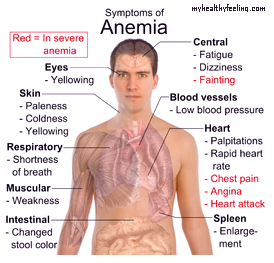When you have insufficient healthy red blood cells in your body, you may have anemia. You may suffer fatigue because there is inadequate supply of oxygen throughout your body because of the reduced quantity of red blood cells that transports the oxygen. There are various causes and types of anemia, each manifesting a wide array of symptoms and requiring different treatment methods.
Anemia is widespread and considered one of the most prevalent health problems in both industrialized and developing countries. Cases of anemia vary, but some of the most common are those caused by nutritional deficiencies in iron, folate and vitamin B12. Chronic infection and ailments, excessive menstrual flow, intake of toxic substances and abnormalities in the genes may also result to anemia.
How does anemia develop?
When there is insufficient absorption of substances that are necessary to produce red blood cells, this results to the development of anemia. One is anemic when the blood lacks the appropriate amount of red blood cells or hemoglobin in the red blood cells. This condition in turn causes oxygen deficiency on the tissues of the body. Red blood cells, also termed as erythrocytes, are the carriers of oxygen that has to be distributed to all parts of the body. Hemoglobin, meanwhile, is the protein in the red blood cell that carries the oxygen and integrates iron into its structure. Iron, hence, is vital in the creation of red blood cells. When iron is lacking, production of erythrocytes is abnormal and leads to changes in color and size of the cells.
The following are the classifications of anemia based on the size and color of the red blood cells.
* Macrocytic anemia – this happens when the red blood cells are bigger than normal size.
* Microcytic anemia – if the erythrocytes are much smaller than normal cells.
* Hypochromic anemia – this is anemia that is characterized by pale red blood cells.
Common anemia: causes and types
As mentioned, there are different types of anemia, depending on their causes. The following are some of the more common causes and types of anemia.
• Iron deficiency anemia. If there is not enough iron in the body, the bone marrow cannot produce sufficient hemoglobin for the red blood cells, since iron is required to make hemoglobin in the bone marrow. If there is lack of hemoglobin due to insufficient iron in the body, this is called iron deficiency anemia.
• Vitamin deficiency anemia. This is the result of vitamin B12 and folic acid deficiency in the body. Vitamin B12 and folate are required to make healthy erythrocytes. If you lack these, plus other vital nutrients, reduction in the production of red blood cells will ensue. There are also cases where the body cannot process vitamin B12 properly. This also results to vitamin B12 deficiency anemia.
• Anemia due to chronic disease. Red blood cell production is also affected by some chronic diseases, like cancer, rheumatoid arthritis, Crohn’s disease, HIV/AIDS, and other chronic inflammatory conditions. This ailment is termed as chronic anemia. Kidney failure may, likewise, lead to anemia.
• Aplastic anemia. This is caused by the inability of the bone marrow to make red blood cells. This type of anemia, though very rare, is life-threatening. Aplastic anemia could arise from autoimmune diseases, infections, and drug use, among others.
• Anemia associated with bone marrow disease. Since red blood cells are produced by the bone marrow, any condition affecting the bone marrow will also have an effect on the production of blood. Many of bone marrow diseases, like myelodysplasia and leukemia, may cause anemia. These bone marrow disorders have a wide range of effects, from small variations in the production of blood; to absolute, dangerous halt to the creation of blood cells. Multiple myeloma, lymphoma, myeloproliferative disorders other cancers of the bone marrow and blood could also result to anemia.
• Hemolytic anemia. This refers to the type of anemia which results when there is higher rate of destruction of the red blood cells. The red blood cell production in the bone marrow cannot cope with the faster rate of destruction of the erythrocytes. There are certain blood disorders that cause the destruction of red blood cells. This could be hereditary or otherwise.
• Sickle cell anemia. This is caused by abnormal hemoglobin that turns the shape of the red blood cell into crescent or sickle shape. These abnormal red blood cells have very short life span, thus resulting to persistent scarcity of red blood cells in the body. Sickle cell anemia is hereditary and often dangerous.
• Rare anemia. Still, there are more types of anemia like thalassemia and those originating from flawed hemoglobin. These, however and rare.
Treatment methods for anemia are as varied as the types and causes. To be able to apply the appropriate combination of treatment procedures, one must consult the doctor. With proper treatment and change in diet plans, anemia could be dealt with and its recurrence prevented.

Thanks for the various tips contributed on this blog. I have noticed that many insurance firms offer customers generous savings if they prefer to insure multiple cars together. A significant number of households currently have several autos these days, particularly those with old teenage children still residing at home, as well as savings with policies might soon increase. So it makes sense to look for a bargain.